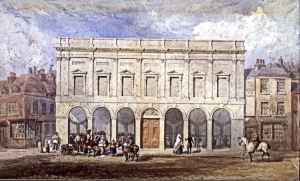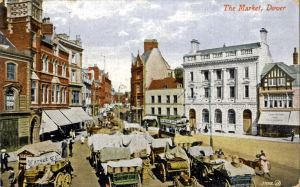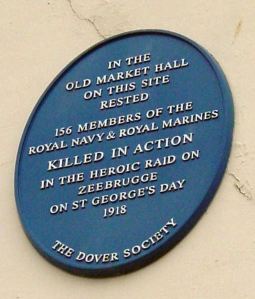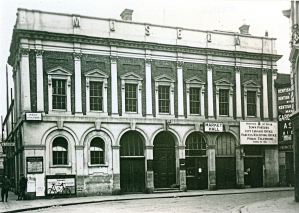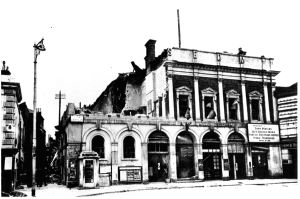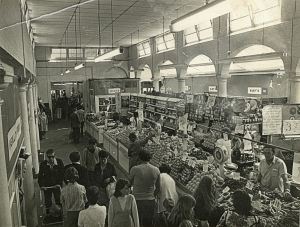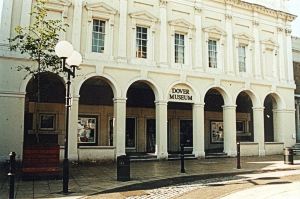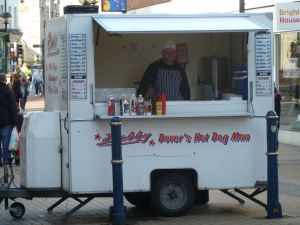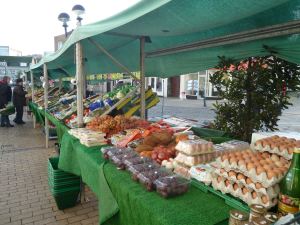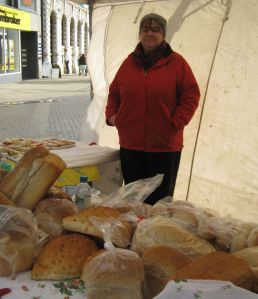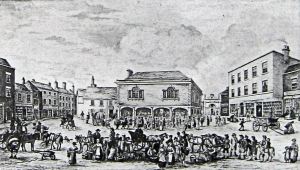
The Court Hall in the Market Square 1822 with the market underneath by John Eastes Youden given by E E Pain – Dover Museum
Markets had existed in Dover for centuries receiving its Royal Charter around 1160. The old Court Hall, which also served as the Town Hall, in the Market Square, opened in 1607. Dover’s main market was held underneath and around about, the area became known as the Shambles. In 1836 Dover Corporation purchased the Maison Dieu and moved from the Court Hall.
Although Dover’s Mayor and Jurats were also the magistrates, separate account books were kept for the council and the courts. The gaol came under the jurisdiction of the courts and when a new gaol was built onto the side of the Maison Dieu, the old one near the Market Square was sold to the Corporation. The council immediately found a private purchaser and stood to make a nice profit until it was pointed out that the newly established Dover Police Force, required a police station with a lock-up!
The council tried but failed to rescind on the deal and the new owner put up the site for sale at public auction. This was held on 2 October 1837 and the Mayor, William Cocke – as the head of the Market Committee, was forced to repurchased most of the site for £555 – making a loss. On the land not required for the police station the council decided to designated for a Market Hall.
In April 1846, Edmund Woodthorpe presented a plan for what became the Market Hall and it was estimated that the edifice would cost £3,000. The lowest tender for building it was £344 and was submitted by local builder George Fry. Accepted, the new Market Hall with a Museum on the upper level opened in 1848. The market was held on Tuesdays, Thursdays and Saturdays, when produce, meat, butter and dairy products were sold. Outside, on the wall, a drinking fountain was erected on 15 May 1849. However, the death knell of the ancient annual St Martin’s Fair, held in November, had been sounded four years before. Following pressure from shopkeepers the council decreed, in 1845, for the fair to cease. The next two years, against the authority’s decree, a fair was held but it evolved into a tatty fun fair and then gradually died out.
In the years that followed the opening of the Market Hall, traders still set up stalls under the old Court Hall. Produce and wares would be sold in direct competition to the indoor Market store holders and local shops. Further, the streets around the Market Square were becoming increasingly busy with traffic. Pressure by the shop owners, backed by the Chamber of Commerce, demanded that the old Court Hall should be demolished. The main justification for this was that the building ‘interfered with the free flow of traffic’. In 1861 the ancient building was knocked down. Of interest, the Town Surveyor – Rowland Rees, had the wooden pillars moved to his garden at the Waterworks. Nonetheless, by the end of the century market traders were setting up their stalls again in the Market Square much to the annoyance of local shopkeepers.
Traders were allowed in the Market Place as of ancient right and upheld by the Local Government Board, as long as they paid a nominal rent to the Council fixed by the said Board. Hawkers – those who did not have a permanent position but sold their wares from a cart – were allowed to trade as long as they had a licence from the Local Government Board. On 26 January 1892, Dover council introduced a local licence to trade in the town and the Hawkers were angry. As one fishmonger explained, his Local Government Board licence worked out at 1d a day for any quantity of fish on his barrow. Dover council’s licence was 8d a day per basket of herrings in order to push his barrow through the streets of the town yet in Folkestone, his central government was sufficient. Things came to a head at a meeting held in the Saracen’s Head pub, Biggin Street, in March 1892, when the ‘Dover Street Hawkers’ Protection Society’ was formed under the chairmanship of Reginald Radcliffe. There were at least 50 members and eventually, the council rescinded their ‘tax.’
During World War I (1914-1918), the Market Hall took on an altogether different role. Initially the indoor market carried on but they were moved out on Sunday 24 February 1916 when 58 bodies recovered from the torpedoed P&O liner Maloja were brought there. Following the incident it was decided to keep the Market Hall free for duration of the war, in case it was needed again for the same purpose. Former traders were allowed to use the building for storage purposes. The Hall was used again following the Nubian being torpedoed on 27 October 1916. On 20-21 April 1917 after an altercation between six German destroyers and two British ships, Swift and Broke and on Sunday 19 August 1917 for civilian casualties following the Crabble tram disaster. It was used again as mortuary in the weeks following 23 April 1918 and the Zeebrugge raid and in September 1918 following the Glatton catastrophe.
Following the War, traders moved back into the Market Hall until the council decided on a major refurbishment and the stalls were transferred to the Market Square. During the refurbishment the Hall was used for events such as the Dover and District Fur and Feather Soiety but the stallholders stayed outside. In order to raise finance for the refurbishment, in 1921 the council agreed to increase tolls by 100% plus parking charges for motor vehicles. There was an outcry but the council were resolute. The Hall was ready for occupancy in 1928 and boasted of purpose built stalls and lock-up facilities but the rent was increased. The traders said that they could not afford the new rent and stayed in the Market Square using their own stalls. On 20 August that year these traders were forcibly removed and afterwards the number of occupied stalls increased to 17. Thirteen sold food items, two were hardware stalls, one a bicycle dealer and a china and glass dealer.
When 1930s economic depression hit, as part of job creation scheme, the council authorised the enlargement of the Market Hall and they allowed allotment holders and market gardeners to sell their produce in the Market Square! For the enlargement the council accepted the tender of £1,698 from Messrs Herbert Godsell of Maidstone and decided to incorporate a heating system. Arora Company, of Loughborough provided the latter for £355. It was proposed to increase the rent to the stallholders but only charge ½d per unit for the heating when the ordinary heating rate in Dover was 1½d. This the traders accepted. However, from 16 September 1934 the Square at night was designated a quiet zone under the Road Traffic Act and this meant that traders had to wait until 07.00hours before they could drive into the Square to set up their stalls within the Market Hall!
The Market Hall took a battering during World War II (1939-1945). At 13.00hrs on 21 August 1940, it was badly damaged and on 26 September four shells fell in the Market Square area, killing two, injuring 18 others and damaging a great deal of property. At 12.50hrs on 21 October that year, a bomb hit the rear of the building, buried tons of foodstuffs and wrecked what was left of the Market Hall. The Market Hall and the Museum above closed for the remainder of the War.
In 1948, despite rainwater coming through the war-damaged roof, there were 23 stallholders in the Market Hall. Fourteen were selling food products, 6 non-food and 3 cafes. Kay Grove and her sister Joan started off with second-hand clothing that was displayed on racks in the bays. When it rained, they move the items into the centre stalls, of which they had four. The non-food stalls did a thriving trade and later, when clothing came off coupons, the women sold men’s new clothing and then diversified into hats, jewellery, furniture, brassware and antiques.
Slowly the building was renovated, the stalls increasingly became occupied and the Market Hall was the favourite shopping area for Dover people. At the entrance was Charley Orme’s cafe and inside Hiltons the butcher and grocer that later became Wilson’s fish shop. There were Hammonds and Hearn’s greengrocers, a wool shop, baby-wear shop, a shoe repairer and many others.
Dover at the time, had a population of 34,240 (2011 – 31,022) and according to a Board of Trade report there were 404 retail shops in the town with an annual turnover of £3.8million. These shops included, 76 grocers, 27 butchers, and 12 fishmongers. The first self-service shop in the town was the Co-op store at Elms Vale in 1950 and six years later, the Biggin Street Co-op was revamped to become Dover’s first supermarket. Since then Dover has seen a plethora of supermarkets come ago, each taking their toll on both the small shopkeeper and market stalls.
In 1966 Dover Corporation voted to promote a Bill through Parliament to stop the erection of market stalls outside of the Market Hall. Six years later, in 1972, a development scheme for Market Square was proposed and this included the demolition of the Market Hall. With the threat of closure, the number of market traders dwindled but about the same time Hatton’s departmental store, in Biggin Street, closed and the remaining 23 stallholders were forced to move there. An indoor market opened in Bench Street in June 1975 but was short lived.
While this was going on John and Mary Dixon, along with members of the New Dover Group (forerunners of the Dover Society) campaigned to save the Market Hall and in 1973 they succeeded in having the façade listed. However, due to the failure of the redevelopment scheme, both the façade and the interior were abandoned and allowed to rot.
The first East Kent Boot Fair was held at Crabble Athletic Ground on May Bank Holiday 1979. Organised by the former Conservative party agent David Meyer (1935-2010), it proved successful. He had the idea from seeing Boot Fairs in the US, advertised the idea and received 400 responses! As the Fairs took off, David moved the business to 201 London Road and lived above the shop. The last Fair David organised was in 1994 before he moved to South Africa.
Pedestrianisation between Market Square and Pencester Road was started in 1980 and it officially came into use on 27 February 1981. It was later extended to the top of Biggin Street. Market traders were allowed to set up in the area but were ‘controlled’. In 1985, the Kent Building Preservation Trust identified 15 properties as historic buildings in the Dover District Council (DDC) area that were endangered by decay, one of which was the Market Hall. At that time, the Council considered rebuilding the back of the façade for a three- storey Heritage Centre. Work had started when it was decided to develop the adjacent site for the tourist attraction – White Cliffs Experience. Work continued on the old Market Hall and it was turned into the Museum we see today.
Regardless that market traders were regularly setting up stalls in the pedestrianised /precinct zone, in 1985/86, the council prosecuted shopkeepers for displaying their merchandise on pavements adjacent to their premises. In response, at the end of 1987, the Dover Chamber of Commerce wrote to the Council asking them to implement the Local Government (Miscellaneous Provision Act 1982) Schedule IV to prohibit street trading there. The council responded by designating the area as ‘consent’ – only entrepreneurs that had gained the council’s ‘consent’ – for which they paid a fee – could have stalls or display merchandise.
Market trading continued in Market Square until January 1988, when the stall holders were moved to Church Street, initially Saturdays then only on Sundays. In June that year an open-air market opened on the former Crypt site in Bench Street. During this time to compliment the short-lived White Cliffs Experience Dover’s town centre was upgraded. Market Square’s roundabout was removed and cobbles, flagstones, attractive lamps transformed the whole area and a fountain in the Square was installed.
January 1993 saw Mr P Mills of Victoria Crescent apply to Dover District Council to sell doughnuts from a tricycle in the Market Square but this was turned down, as it was said, it would conflict with rate-paying businesses in the vicinity. That same year the shopkeepers in the Precinct announced that they welcomed a plan to have a Thursday market outside their shops. Councillors disagreed saying that a street market would create problems for the said shopkeepers! Then the shopkeepers rates were increased by 300% and they changed their mind. Of note, shops pay a business rate or property tax that is assessed by the Valuation Office Agency who equate it with what they perceive as the annual rent the property would fetch on the open market, street venders, on the other hand, pay rent to DDC.
At about that time, Lincolnshire Markets were given permission to hold a market on a derelict site adjacent to the Charlton Centre in the High Street (now a doctors surgery complex), much to the horror of the Centre manager, other local shopkeepers and the Chamber of Commerce. It was opened by DDC chairman Bill Chesterfield in October 1993 and was held every Friday and Saturday. It was about this time that people started to park their cars in the streets offering them for sale. Both residents and commercial garages complained loudly and in areas designated as ‘consent’ a £100 trader’s licence was imposed. This brought a further outcry as parking bays soon became blocked with second hand cars being offered for sale.
1996 saw ice cream seller, Alan Rolfe of Lewisham Road, who had the previous summer allowed to operate in Biggin Street, refused permission to extend his area to Cannon Street on the grounds that it would conflict with existing traders. Albeit, slowly there was a change of heart and the Dunfords family moved their fresh vegetable stall from Church Street into the Precinct and it is still going strong. In April 1998 Bob Royston of Clarendon Place received permission to set up a hotdog stall in Biggin Street and is still successfully operating, now under a different operator.
A joint initiative by KCC and DDC, IMPACT, was started in 1996 that provided for the Town Centre Management Company Ltd (TCM) – chairman Alan Elcocks of Boots the Chemists in Biggin Street. The remit was to ensure that the town became ‘a thriving community with profitable businesses, where residents were happy to shop and relax and a place that visitors will return to.’ In 1998 Tina Pullinger, Dover’s Town Centre Manager, instigated the setting up of a French Market on 12 and 13 December. The traders sold a wide range of products and the event was a great success but local shopkeepers complained the stalls obstructed the entrances to their shops.
Nonetheless, similar occasional markets were instigated and in 2010 the Dover Chamber of Commerce, through its Dover Business Support Initiative, launched a Saturday market in the Market Square and Cannon Street. Market traders were charged £440 a year if they had a stall in the same place throughout that time and £112 for an occasional licence. In November 2012, the Bluebird Market, operating on Tuesdays was launched. In the early hours of nearly every Tuesday John Angell, who owns a jeweller’s shop that dates back to 1830, in Biggin Street, can be seen erecting stalls ready for market traders … showing that shops and markets can work together in Dover!
- Published:
- Dover Mercury: 22 June 2006
:

